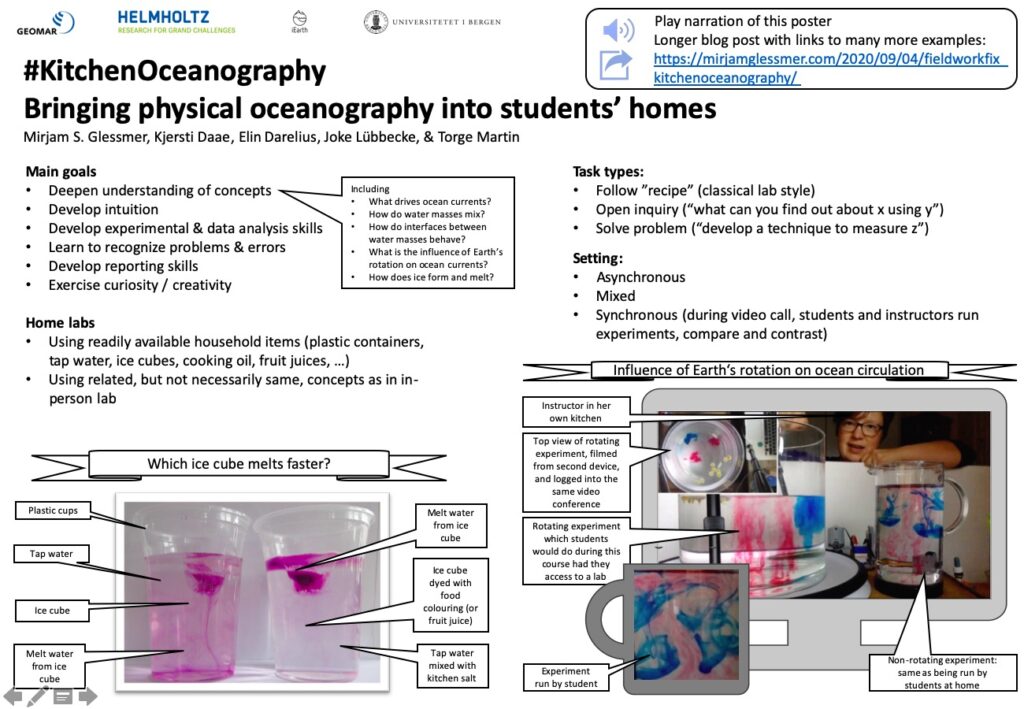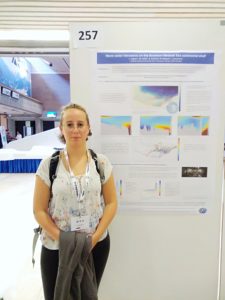This is a (admittedly terribly crowded — but I only had 1 A4 page and there are so many interesting #BergenWaveWatching stories to tell!) poster that I am presenting on behalf of myself (Mirjam), Kjersti Daae and Elin Darelius at the #FieldWorkFix conference (September 8, 2020). If you would rather listen to my poster’s voiceover than read the transcript below, please feel free to do that here!

Welcome to our poster!
The most important learning outcomes that, in my opinion, need to be achieved with a #FieldWorkFix are to enhance motivation and interest in concepts that are being dealt with theoretically in class, and in the students’ subject in general. When students are isolated in their homes and don’t have an inspiring community of learners in their field around them, it is so important to maintain a connection to their field of study! And one way to do that is by helping them realize that what they study is relevant and meaningful in the way that it helps them explain the world they see (even if they previously neither noticed nor felt the need to explain the waves on a puddle they accidentally stepped in).
There are different types of tasks that can help students achieve that level of observation and fascination with their subject (and if you are interested in what specific tasks can look like, check out the link on our poster, that will lead you to a blog post that links to all the different examples I am giving in the following, with tons of pictures).
For example, students could be asked to find realizations of a phenomenon in the world around them. It’s good to start with an easy example that they can definitely find in many different locations. In our case, “find a hydraulic jump” works well, because those can be generated artificially by turning on the tap in your sink, or can be observed near any weir, most rain gutters, and many rivers. These examples can be shared via the classes content management system or via social media – both work well and offer the added benefit of requiring some sort of description and explanation of what was observed and where, thereby practicing both note-taking and reporting skills.
Students could also be asked to observe a specific phenomenon in a specific place and discuss how the time of observation might have influenced what they saw, and how they would set up a schedule for observations that would be best suited to document the phenomenon. An example for that is looking at a tidal current underneath a specific bridge. Depending on what time and what day it is observed during the spring and neap cycle, the flow might be observed having different strengths or even going in different directions.
I am also a big fan of the more open “find something interesting to observe that is somehow related to the concepts discussed in class”, and being open to what students come up with. If you are worried about students not finding something interesting, I would encourage you to look at my Instagram @fascinocean_kiel, where I have almost 900 pictures of mainly waves (and a few other interesting oceanic phenomena) with explanations of what I saw. Once you start looking, there is physics everywhere!
The best thing about a collection like the one on my Instagram (or the one you are building by asking students to document their observations) is that they can be used for an indoor version of this #FieldWorkFix: Assigning pictures to students with the task to annotate and explain what they see. (Which is surprisingly difficult! I get often sent #FriendlyWaves; pictures of water with the request to explain what is going on there, and while it is very entertaining and educational, it is also really difficult because many of the relevant metadata does not come with a picture).
And finally, one could give the very open task to either come up with, or answer a given, research question by doing observations in the neighbourhood.
Depending on the social distancing requirements, all these tasks could be assigned to students working either in teams or by themselves. But if one of the learning outcomes is to practice working in teams, as it often is, this can be accommodated either way:
Several students can work together on the same research question and either do this together, or – which is most likely the mode they would choose in any case – divide work and take turns taking observations. This means they are also developing observational and collaboration skills: all have to be on the same page when it comes to what properties to observe by which methods and at what place and time, how to document, how much and what kind of metadata needs to be archived, how work is split between the students, et cetera.
Students could also be given complementing tasks that they each complete individually, knowing that they will ultimately have to put their results together like a puzzle. This, again, practices a lot of observational and communication skills.
The results of these tasks can be brought together either asynchronous, i.e. students report back in writing via the content management system or social media, or synchronous in video calls where students give presentations and there is a group discussion.
Lastly, one of the big learning outcomes often associated with field work is building students’ “identity as scientists”. Students come back from the field and talk about how we, meaning we oceanographers, or more generally, we scientists, do field work. Of course, the experience of a local field trip is not the same as a multi-day research cruise. But looking for phenomena related to ones field of study has an effect on how one sees the world. Very quickly, students will look at the world with different eyes, seeing physics where other people see the sparkly ocean or a fluffy cloud. This change in perception helps students feel like a specialist on their subject, as someone who has a deeper interest and wider knowledge than most people around them, and who looks at phenomena more carefully, trying to understand them. And this is a vicious circle: once hooked, it is difficult to stop looking at the world through that lens. Which is exactly what we wanted!
Thank you for your attention!


